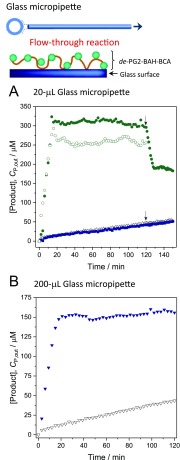Figure 7.
(A) Time courses of flow-through reactions with “20 μL micropipettes” containing immobilized conjugate de-PG21000-BAH175-BCA115 (filled circles) or adsorbed free BCA (filled squares); results from a “20 μL control micropipette” are also shown (empty triangles, no BCA). PB3 initially containing 1.0 mM p-NA (pH = 7.2) was continuously passed through the micropipettes. The absorption spectrum of the solution eluting from the micropipettes was measured, and A405 was converted into Cp,out = [p-nitrophenolate] + [p-nitrophenol] (see section 2.10). The flow rate was 2.7 μL/min (mean residence time τ = 15 min) for the first 120 min, and then at the time indicated by the arrows, the flow rate was increased to 5.7 μL/min (τ = 7.0 min). The empty circles are the data for a “20 μL micropipette” containing immobilized de-PG21000-BAH175-BCA115, which was washed first with PB3 before the substrate solution was pumped trough. This washing was at a flow rate of 14.3 μL/min for 218 min. (B) Reaction time courses for a “200 μL micropipette” containing immobilized de-PG21000-BAH175-BCA115 (filled reverse triangles) and for a “200-μL control micropipette” (no, BCA, empty reverse triangles). The reaction was performed by passing the substrate solution at a flow rate of 18.4 μL/min (τ = 15 min) through the micropipette.

